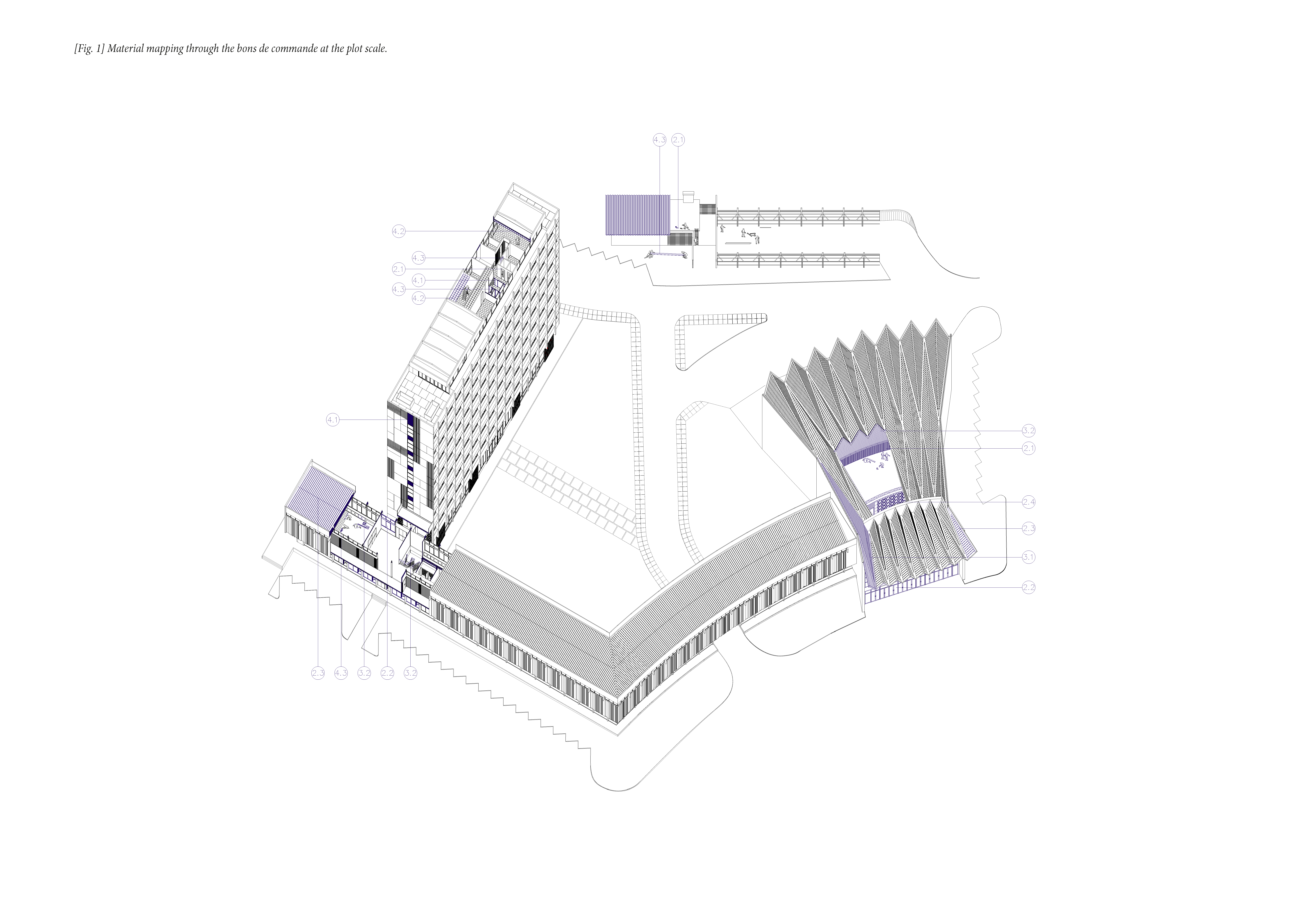Master dissertation by Laure Bosseloo & Amber Degezelle

Pretending as if buildings simply appeared on the surface of the earth, architectural historians have long barely focused on construction. Interpreting architecture along art-historical lines, they equaled architectural designs with buildings, and failed to unpack the processes underneath their materialization. Construction historians, on the other hand, did explicitly take the construction of buildings as their object of study. However, their focus on the builders and the construction site itself, similarly shoved the preceding processes of material extraction and production aside as irrelevant for the field. However, as American scholar Kiel Moe so strongly states, we are in an age that no longer tolerates such disciplinary aversions. It is only by trying to identify the worldly processes of building —in particular the extraction of raw materials, the production of building materials and the transportation of these materials towards building sites— that we can truly start to grasp the ecological, climatological, economic and political dimensions —the building ecologies— of architecture.
This thesis uses such terrestrial descriptions, as Moe calls it, to describe the state architecture in the Democratic Republic of Congo, previously known as Zaïre (1971-1997). Trying to understand where, why and how these buildings came about, and how building materials for the emblematic state projects were sourced, we will try to go beyond Mobutu’s Recours à l’Authenticité narrative. Such narratives might reveal just how strongly these authentic architectures were anchored in narratives of cold war politics, in continued Belgian influences, and in global economic logics.
This thesis focused on one of the most emblematic projects realized during the Mobutu reign: the Ministry of Foreign Affairs. Building on the contractor’s archive, and the particular source of the bons de commande (procurement forms) Amber and Laure mapped the material flows that were at the basis of this building. After a quantitative analysis of these bons they tried to trace the histories of a selected set of building materials and building components. Following such elements as the bacs autoportants, the wood used for the building’s scaffolding, the copper interior panels, or the modernist-style furniture produced in Kinshasa, they take their readers on a fascinating journey across the globe, while tackling grander issues like material toxicity, labour exploitation and (neo)colonial continuities in the construction industry.
The work not only resulted in a heft and rich book, but also in a fascinating axonometric drawing of the building, in which Laure and Amber made visible all components under scrutiny.
— Robby Fivez & Johan Lagae

Material mapping through the bons de commande at the scale of the building plot
While previous research has extensively explored the influence of post-colonial politics and economics on Congolese architecture, the intricate material flows and global networks that underpinned these monumental projects have received less scholarly attention. This research critically examines the architecture of post-colonial Congo, with a particular focus on the construction of the Ministère des Affaires Étrangères (MINIAF) in Kinshasa during the regime of Mobutu Sese Seko. It addresses the gap by meticulously tracing the origins, transportation, and application of materials used in the construction of the MINIAF. Drawing on comprehensive research on the archives of the Compagnie Congolaise de Construction (C.C.C.), housed at CIVA in Brussels, the study reveals not only the technical and logistical dimensions of the construction process but also the complex interactions between local and international actors that shaped Congo’s architectural landscape. The MINIAF, emblematic of Mobutu’s nation-building endeavors, serves as a critical lens through which to explore the broader political, economic, and environmental implications of architecture during this transformative period in Congo’s history.
The study’s methodology is firmly anchored in a material-based approach to architectural history, moving beyond traditional narratives centered on style and theory to investigate architecture as a dynamic process encompassing the entire lifecycle of building materials—from extraction and production to transportation and assembly. This approach is operationalized through a detailed material mapping exercise that leverages archival records, particularly the bons de commande (purchase orders), to trace the origins and movements of materials utilized in the MINIAF. The mapping is conducted across multiple scales: from the building and plot level in Kinshasa, to the city and national scales, and ultimately to the global scale, thereby illuminating the intricate interconnections between the project and international supply chains and economic logics. By dissecting the building into its material components, the research exposes the intricate networks linking Kinshasa’s urban landscape with distant sites of material extraction and production.
This material-centric methodology uncovers the ecological and economic dimensions of Mobutu’s architectural projects, revealing the paradoxes inherent in post-colonial development where the pursuit of national identity frequently conflicted with ongoing economic dependencies and the environmental costs associated with resource extraction. The ecological impact of these material flows is further explored through a detailed case study tracing the transformation of a tree log into formwork for the building’s concrete structures, illustrating the broader environmental consequences of such large-scale construction projects. Additionally, the research addresses the issue of toxicity, particularly through the use of asbestos-cement, by tracing its global journey from Canadian mines to its application in Kinshasa, and by examining the socio-political dynamics that permitted its continued use despite known health risks.
The integration of diverse sources and themes within this research provides novel insights into the architecture of post-colonial Congo, situating an analysis of material flows within a broader framework of political, economic, and environmental contexts. The study argues that the construction of the MINIAF and similar projects cannot be fully comprehended without considering the global networks and local practices that shaped them, thus offering a more nuanced understanding of how architecture functioned as both a symbol and a tool of power during Mobutu’s regime. Through this comprehensive examination, the dissertation contributes significantly to the understanding of the socio-spatial transformations that have characterized Congo’s post-colonial period and continue to influence its contemporary realities.
— Laure Bosseloo & Amber Degezelle